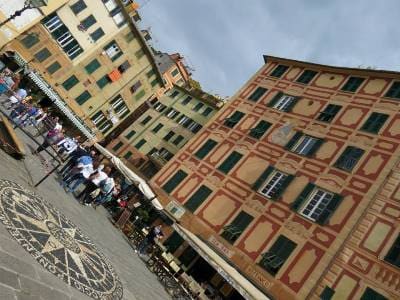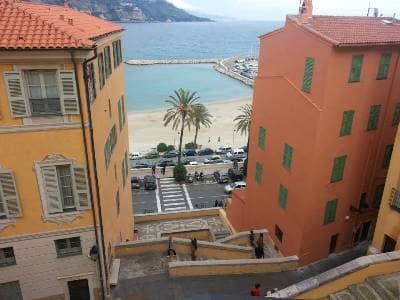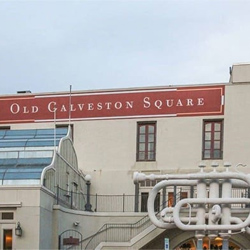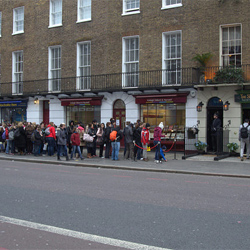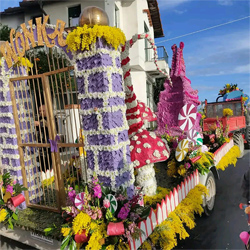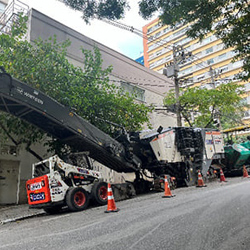In our region, Liguria, and especially around the city of Genoa and the East coast, many façades of palaces
as well as some of common buildings are decorated with rich and beautiful details.In architectural terms this technique is called ‘trompe l’oeil,’ a French term meaning ‘illusion for the eye.’ It seems that this quite old form of art was in part generated by the need to replace stucco decorations that are perishable especially by the seaside where we live. In fact, the salt in the air easily corrodes the stones of the façades and the cornices that therefore needed to be replaced with cheaper and more easily restorable decorations such as common paint.The buildings in Liguria are traditionally painted in pastel colors with hues of pink, yellow and orange but in recent times, due to the expensive cost and low availability of pastel color paint, they are often painted in bright yellow, red or hot pink.

Ligurian façades are traditionally in pastel colors
The antique Genovese-style trompe l’oeil technique gained popularity towards the end of the 15th century when some rich families in Genoa decided to hire some artists to repaint the decaying and salt-eroded façades of their noble abodes. The artists decided to repaint the walls with pastel colors and added some illusory images to give room to their imagination and artistic flair.This is what history tells us, but there is another version of the story that brings us back to a controversial initiative that affected property taxes at the turn of the 15th century: the so-called window tax.In agreement with this window tax the calculation of the property tax was based on the number of windows a house had and given that rich palaces and luxurious mansions had many windows the amount to pay for the nobles would be higher. According to this legend, in order to pay fewer taxes, the nobles decided to eliminate some windows in their residences and replace them with painted ones that were leaving the harmonious style of the façade while costing less.
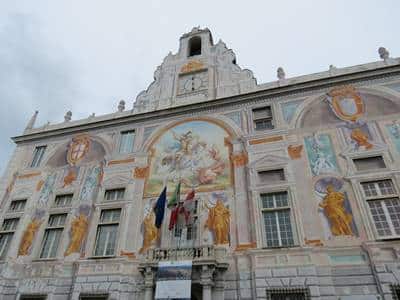
Trompe l’oeil style façade with painted columns and statues
Wherever the truth may lie we know that the end result was that stone and marble decorations began at that time to be replaced by this ‘trompe l’oeil’ artistic painting style and the decorations now range from painted columns to entire windows, at times with half-closed or open shutters offering a peek on the imaginary interiors of the houses. Sometimes these decorations depict balconies with iron railings or they even show flower vases displayed on the windows or cats that stick out from behind the (painted) curtains. Sometimes the illusion is so strong, that it really deceives the eye and it’s hard to distinguish trick of vision from reality especially if you are a passer-by and you are looking from a few meters down below.
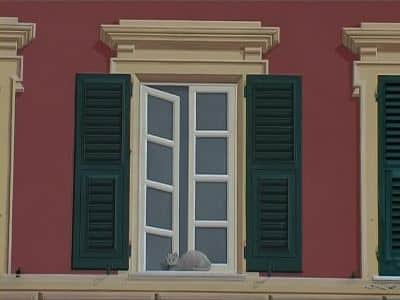
Optical effect depicting a window and a cat
More often the effect plays on complex and refined decorations that use the natural light to give the buildings a geometrical 3-D effect of bas-relief.
Geometrical 3-D effects are painted on the façades
Most decorations on the Ligurian façades are made to evoke moments of a utopian daily life and appeal to ancient times. Liguria after all is a land of dreamers, explorers and fishermen and it’s a place where tradition is maintained and cherished.Nowadays the colors of the façades are bright hues of red, yellow or pink but some of them maintain the more traditional (and more expensive) pastel colors.I was once told that if the owner of a building with these unique architectural features intends to repaint the façade of his building, first he has to present a proper project to the City Hall for approval and find house painters specialized in this technique who obviously need to have a skilled artist hand and specific preparation.I also discovered that in the municipalities the person responsible for monitoring the ornate façades of these buildings is an architect who has to attend specific courses before being given this assignment by the city. The architect’s task is to monitor the façades listed on the local architectural heritage and report any noncompliance or deterioration.I believe that it’s miraculous that the phenomenon could escape the dictatorship of modernism because other buildings featuring unique styles (such as art deco or postmodern) have unfortunately been transformed or demolished through the decades to give room to high rise buildings.



